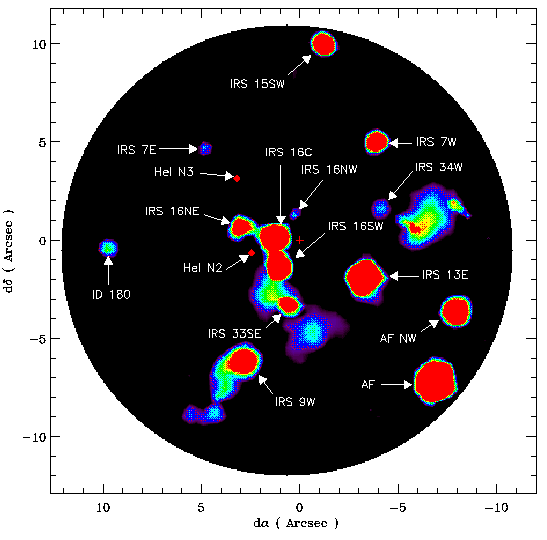
A Strange Collection of Stars at the Galactic Center
Credit: Image courtesy of J.P. Maillard & T. Paumard
Institut d'Astrophysique de Paris, France

On February 28th an image of the
center of our Galaxy was the featured picture of the week. The
presence of a Black Hole was suggested at the center of the Galaxy to
explain the rapid stellar motions that are measured in the field next
to Sgr A*. This week we feature the Galactic Center again, but for a
different reason: the number of peculiar stars it hosts!
Recently, a team of French Astronomers lead by Jean-Pierre Maillard
used the Fourier Transform Spectrograph (FTS) on the
Canada-France-Hawaii Telescope to image the Galactic Center and search
for objects known as Helium Stars. These stars are rare because very
short-lived. Oddly, a large number of them was found near the Galactic
center.
We believe that one of the "side effects" of having a black hole at
the center of a galaxy is to produce a "starburst", an episode of
very intense star formation. Howewer, the presence of the rare Helium
stars in such large number is difficult to understand with this model.
The images obtained by the group of astronomers allowed to understand
better the nature of these objects. Because FTS is an imaging
spectrograph, it is possible to efficiently select only those
stars that are, for example, Helium-rich among the large number of
objects present in the field-of-view. Indeed, 16 sources are detected
by FTS in the Helium line close to the Galactic center. This is more
than anywhere else in the Galaxy! The 16 sources are identified in
this week's image, and some of them are also identified here for comparison and orientation
with the image of the week of February 28th. Note that this image was
obtained with Adaptive Optics. It has better angular resolution but
lacks the spectrosocpic capacity of FTS. Both techniques complement
each other nicely.
Further clues to the nature of these Helium stars were revealed by
the images presented here. Interestingly, two classes of Helium stars
seem to be present and distributed differently. Bright Helium stars
are grouped in a compact cluster in the immediate neighbourhood of the
Sgr A* (the Galactic center, indicated by the red + sign at the center
of the image). They are found mainly in the IRS-16 cluster. On the
contrary, the fainter Helium stars are located slightly further from
the center, within a radius of ~0.4parsec (~1.3 light-years). The
existence of these two distinct groups probably traces a difference of
evolution, with the more evolved and brighter stars likely in the
Wolf-Rayet phase of their evolution and located in the central
cluster.
The image presented this week was obtained in July 1997 with the
imaging Fourier Transform Spectrograph (FTS)
attached to the Canada-France-Hawaii Telescope. The instrument, called
BEAR, operates in the near infrared and allows integral field
spectroscopy over a field of view of 24 arcseconds.
In the image presented here, the instrument was tuned to measure a
neutral Helium line at a wavelength of 2.058 microns. A cube of 300
images of 10 second exposure time was needed to produce this
picture. The stellar continuum adjacent to the line was carefully
subtracted to better allow identification of the Helium stars.
Extended patches of diffuse Helium emission remain (visible in green).
They trace interstellar gas.
Technical description:



